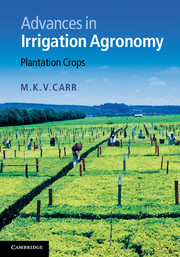3 - Cocoa
Published online by Cambridge University Press: 05 May 2012
Summary
Introduction
The centre of diversity of the cocoa tree (Theobroma cacao L.) is believed to be within the rainforests of lowland northern South America where the greatest range of variation in natural populations exists (Cheesman, 1944; Simmonds, 1998). The plant is grown for its fruits known as cocoa pods (botanically indehiscent drupes). The pods contain seeds, which are fermented with the mucilage surrounding them and then dried to give fermented dried cocoa, the raw material used in the food industry for the production of chocolate and powder (for drinking, baking and ice cream manufacture). A small proportion is also sold as cocoa butter, which is used in the pharmaceutical and cosmetic industries (Wood, 1985a).
In its natural habitat cocoa is a small tree in the lower storey of the evergreen rainforest. Cocoa has been cultivated since ancient times (at least 2000 years) in Central America, from Mexico to southern Costa Rica. After the arrival of the Spaniards in the sixteenth century, cocoa spread rapidly in the New World. It was introduced into South-east Asia in the seventeenth century and to West Africa in the nineteenth century. By 2008, the total planted area of cocoa in the world was estimated to be about 8.6 million ha, of which 67% is in West Africa and only 17% in the Americas and the Caribbean. It is nearly all grown within 20° N and 20° S of the equator (World Cocoa Foundation, 2010). The largest individual producer is Côte d'Ivoire (1.22 million tonnes; 2.3 million ha in 2008), followed by Ghana (662 000 t; 1.75 million ha), Indonesia (490 000 t; 990 000 ha), Nigeria (250 000 t; 1.15 million ha), Cameroon (227 000 t; 500 000 ha) and Brazil (157 000 t; 641 000 ha) (areas harvested from FAO, 2010a: production from ICCO, 2010). West Africa now produces 69% of the world's annual total of 3.6 million tonnes of cocoa. The market value of the cocoa crop is US$5.1 billion (World Cocoa Foundation, 2010).
- Type
- Chapter
- Information
- Advances in Irrigation AgronomyPlantation Crops, pp. 53 - 75Publisher: Cambridge University PressPrint publication year: 2012

